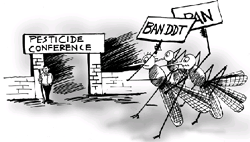Study reveals pollution of four river basins
Unscientific disposal of sewage and pesticide residue from farmlands have contributed to organic pollution and chemical contamination of surface and groundwater resources in four river basins across the
Unscientific disposal of sewage and pesticide residue from farmlands have contributed to organic pollution and chemical contamination of surface and groundwater resources in four river basins across the
Keoladeo National Park (KNP) is an important wintering ground for thousands of birds that undertake a perilous journey over the Himalaya to make a seasonal home in a wetland ecosystem. However, this wetland
April 30: The state agriculture department has directed all the pesticide manufactures in the state to implement the ban on the use of Monocrotophos on vegetables and a total ban on 28 other pesticides. The Central Insecticide Board and the Registration Committee has banned 28 pesticide formulations which include Endrin, Calcium Cyanide and Aldrin.
The objective of this study was to investigate extent of contamination of groundwater (potable and irrigation) of Aligarh district by pesticides and heavy metals during last 11 years (1996-2006)
The ground water quality of the 14 Metropolitan Cities of Faridabad, Delhi, Jaipur, Bhopal, Indore, Jabalpur, Nagpur, Nasik, Pune, Bangalore, Hyderabad, Vishakhapatnam, Patna and Kochi has been assessed to see the suitability of ground water for domestic and irrigation applications. Twenty five ground water samples were collected each during pre- and post-monsoon seasons in the year 2004 and analysed for various physico-chemical and bacteriological parameters, heavy metals, pesticides and polynuclear aromatic hydrocarbons.
<p>A solid phase extraction and gas chromatography with negative chemical ionization mass spectrometry in scan mode (GC-NCI-MS) method was developed to identify and quantify for the first time low levels of organochlorine pesticides (OCs) in plasma samples of less than 100 ?l from wild birds.
A solid phase extraction and gas chromatography with negative chemical ionization mass spectrometry in scan mode (GC-NCI-MS) method was developed to identify and quantify for the first time low levels of organochlorine pesticides (OCs) in plasma samples of less than 100 ?l from wild birds.

Looks as if they are going the way of the dodo
Foodstuffs collected from different regions in India were analyzed for the presence of HCH (BHC), DDT, HCB, aldrin, dieldrin, heptachlor, and PCBs. Significantly high levels of food contamination with HCH, DDT, aldrin, and dieldrin were evident throughout India. Dairy products and livestock meat are the prime sources of human dietary exposure to these chemicals.

Negotiators at a United Nations sponsored meeting in Geneva have decided to eliminate eight toxic pesticides and chemicals. However, DDT remains a contentious issue